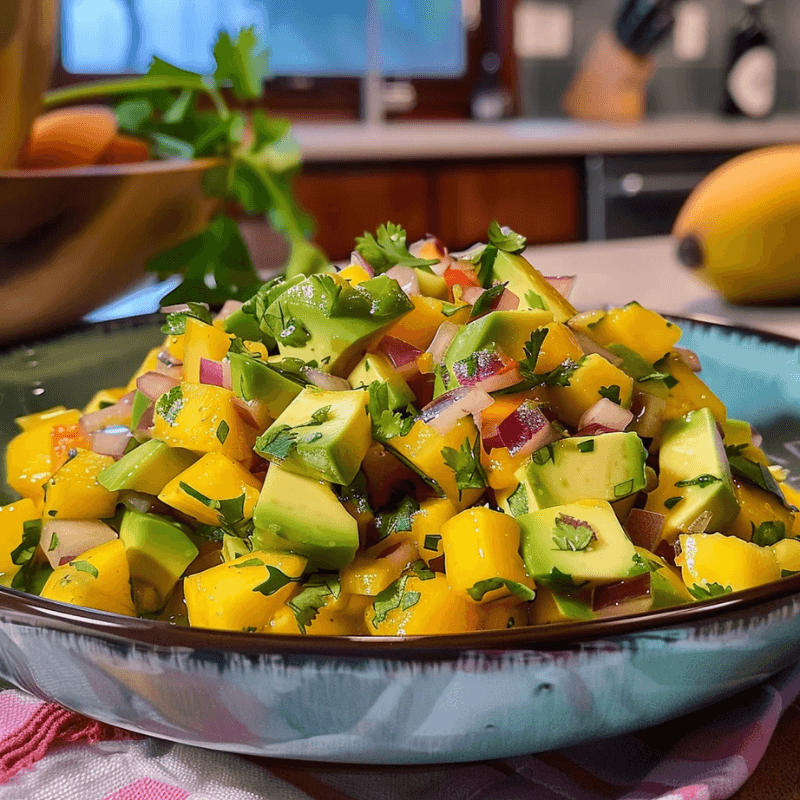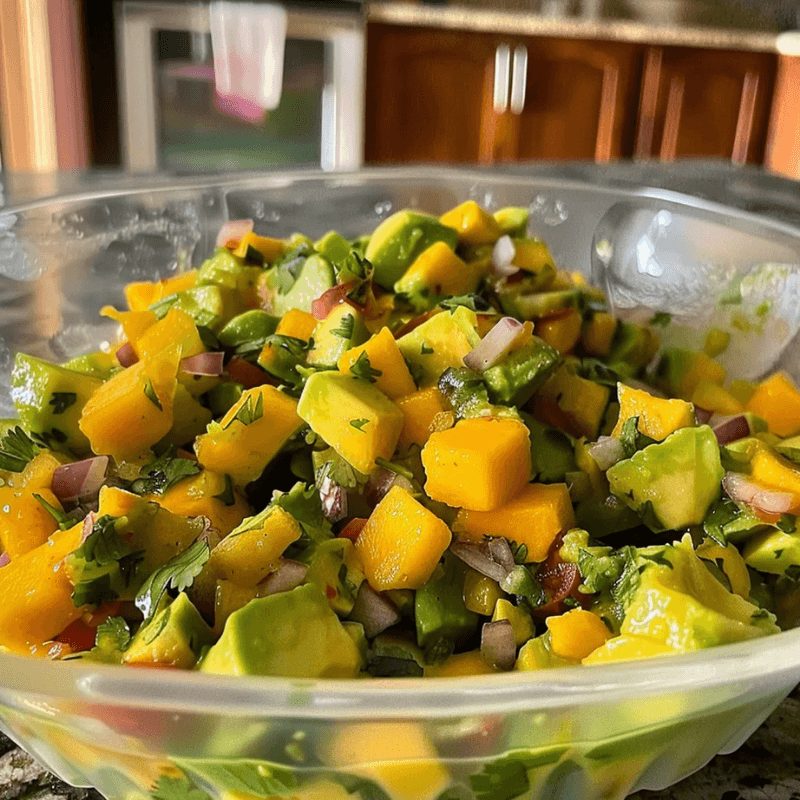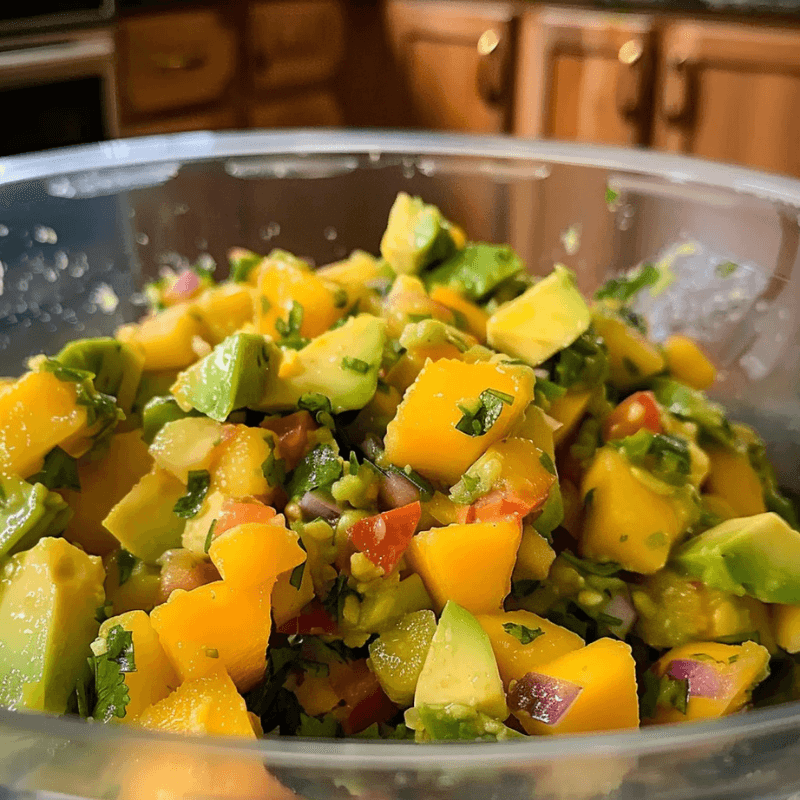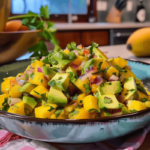This avocado and mango salsa takes just 10 minutes to prepare, making it perfect for busy cooks who want to create something extraordinary. With only 8 simple ingredients, we’ve created a sweet, creamy, and spicy combination that works equally well as an appetizer or a topping for grilled meats.
In fact, this versatile salsa isn’t just delicious – it’s nutritious too. Each serving contains just 63 calories while providing 15% of your daily Vitamin C needs. Whether you’re serving it with tortilla chips or using it to elevate your favorite tacos, this recipe delivers a perfect balance of sweet and salty flavors with a tangy hint of lime.
We’ll show you exactly how to make this crowd-pleasing salsa, share our best preparation tips, and reveal the secrets to getting the perfect texture every time.
The Secret to Perfect Avocado and Mango Salsa
The magic of great avocado and mango salsa lies in its perfect balance – a harmony of contrasting elements that dance together on your palate. Unlike many store-bought alternatives, a well-crafted homemade salsa delivers an experience where no single flavor overpowers the others.

Balancing sweet, spicy, and tangy flavors
Creating the perfect avocado and mango salsa requires a delicate equilibrium between three core flavor profiles. The sweet tropical notes from ripe mangoes provide the foundation, counterbalanced by the heat from jalapeños or serranos, and brightened by the acidic punch of fresh lime juice.
The acid in your salsa serves two crucial purposes. First, it adds its own distinctive flavor element. Second, it makes all other flavors more vibrant and pronounced. As one chef notes, “The acid not only adds its own element to the overall flavour of the salsa, it also makes all of the other flavours pop”.
A proper mango salsa needs that spicy kick – it doesn’t need to be overwhelmingly hot, but that element is essential for authenticity. The type of chile you select significantly impacts both heat level and flavor profile. For milder salsa, remove seeds and membranes; for extra heat, leave them in or add more peppers.
Orange juice works surprisingly well alongside lime juice in this salsa. Beyond adding sweetness, it complements the tropical mango notes and balances the spice and acidity beautifully. For those who prefer more sweetness, a touch of honey or brown sugar can further enhance the flavor profile.
Achieving the ideal texture
Texture plays an equally important role in exceptional avocado and mango salsa. The creamy avocado should complement the firmer mango pieces, creating a delightful contrast in each bite.
For optimal results, dice all ingredients into similar-sized, bite-sized pieces. This consistency ensures balanced flavors and textures in every scoop. When selecting avocados, look for ones that are ripe but still slightly firm – they’ll hold their shape better when mixed with other ingredients.
When incorporating avocado, add it last and mix gently. As one expert advises, “Be gentle and lightly toss to combine. Don’t mash it up, or you’ll end up with mango guacamole”. This careful handling preserves the distinct textural elements that make this salsa special.
Additionally, allowing your salsa to rest for 10-15 minutes before serving permits the flavors to meld together. This resting period transforms your ingredients from separate elements into a cohesive, flavorful whole.
Why fresh ingredients matter
The quality of your ingredients directly impacts the final product. Fresh salsas made from raw, high-quality components deliver authentic flavors and maximize nutritional benefits.
From a nutritional standpoint, fresh salsa ingredients provide significant health benefits. A typical serving contains approximately 39 calories with minimal fat (0.26g), making it a guilt-free addition to your meal. The ingredients in fresh salsas can aid digestion and provide essential vitamins and minerals.
Furthermore, fresh ingredients offer vibrant flavors that processed alternatives simply cannot match. As one chef explains, “Fresh salsa has a fresh flavour… that big hit of freshness”. This brightness is particularly important in avocado and mango salsa, where the natural sweetness of ripe mango plays against the creamy richness of avocado.
Fresh lime juice, rather than bottled alternatives, makes a noticeable difference in your salsa’s brightness and zesty quality. Similarly, selecting properly ripened fruits ensures optimal flavor – underripe mangoes lack sweetness, and overripe avocados become mushy.
Remember that simplicity remains key to exceptional salsa. The best versions typically contain no more than five or six carefully selected ingredients that complement each other perfectly, allowing each component to shine through without competition.
Selecting and Preparing Your Ingredients
The foundation of any exceptional avocado and mango salsa begins long before the mixing bowl. Success hinges on selecting ingredients at their peak ripeness and preparing them properly. Here’s how to ensure every component contributes its best qualities to your final creation.

How to choose perfectly ripe mangos
Finding the perfect mango requires attention to both appearance and feel. Ataulfo or Champagne mangos make an excellent first choice due to their juicier texture and sweeter flavor compared to red varieties. When examining mangos, look beyond color – the ripeness test comes down to gentle pressure.
Hold the fruit in your palm and apply slight pressure. A perfectly ripe mango should yield just slightly, similar to a new tennis ball when gently squeezed. If it feels hard as a baseball, it’s not ready; if it yields significantly with leathery, loose skin, it’s likely overripe.
For meal planning purposes, consider buying firm, unripe mangos and allowing them to ripen at home on your countertop. This process typically takes 3-5 days, so plan accordingly. Once ripened, refrigeration can slow the process if you’re not ready to use them immediately.
Picking the best avocados
Since avocados form the bulk of this salsa, selecting prime specimens is crucial. Begin by examining the skin color – choose avocados with forest green coloration. Vibrant green indicates under-ripeness, while completely brown suggests over-ripeness.
Next, inspect the naval (stem end) of each avocado. If you can easily flick off the naval, the avocado is officially ripe. If it remains tightly attached, the fruit needs more time; if the naval is missing entirely, that avocado may have brown spots inside.
Finally, perform the pressure test by giving the avocado a gentle squeeze with your palm. A ripe specimen will feel just slightly soft. For chunky salsa that holds its shape, avoid mushy, overripe avocados. To ripen avocados at home, leave them on the counter for several days, checking daily for that perfect tennis-ball firmness.
Onion preparation tricks to reduce sharpness
Raw onions can overwhelm other delicate flavors in your avocado and mango salsa. Fortunately, several techniques effectively reduce their intensity without sacrificing flavor.
The most effective method involves soaking sliced onions in ice water for 30-60 minutes, which significantly dilutes the harsh enzymes. Alternatively, if you’re short on time, place unpeeled onions in the freezer briefly or rinse under cold water.
Another approach involves quick-pickling the cut onions in vinegar for a few minutes. Acidic solutions dissolve the enzymes responsible for onions’ sharp bite. Throughout the preparation process, remember that milder varieties like white or Vidalia onions, shallots, or spring onions naturally contain less pungency.
Handling hot peppers safely
The capsaicin in hot peppers – concentrated highest in the seeds and pith – requires careful handling to prevent painful burns. Always approach hot pepper preparation with caution, especially when using intensely spicy varieties like habaneros, which are 20-30 times hotter than jalapeños.
Wearing gloves provides the safest approach when handling hot peppers, particularly for those with sensitive skin or open cuts. If you choose to work without gloves, develop the habit of not touching anything while cutting peppers, then wash your hands and knife thoroughly immediately afterward.
Be especially vigilant about avoiding contact with your eyes, nose, or mouth during preparation. For additional protection when cutting very hot peppers like habaneros, consider wearing a mask or handkerchief over your face, as the airborne capsaicin can create a pepper-spray-like effect that causes coughing and eye irritation.
For a milder salsa that maintains flavor without overwhelming heat, remove the seeds and white membrane of hot peppers before adding them to your mixture.
Step-by-Step Mango Salsa Recipe
Now that we’ve covered the theory, let’s roll up our sleeves and dive into creating your ultimate avocado and mango salsa. This vibrant dish comes together in less than ten minutes and requires no cooking – just fresh ingredients and proper technique.
Essential ingredients list
For the perfect avocado and mango salsa, gather these fresh components:
- 1 large ripe avocado, peeled, pitted and diced
- 1-2 ripe mangos, peeled and diced (about 2 cups)
- 1/2 cup diced red onion
- 1-2 jalapeños, seeded and finely diced (adjust for heat preference)
- 3 tablespoons fresh lime juice (about 1 1/2 limes)
- 3 tablespoons fresh orange juice
- 1/4 cup chopped fresh cilantro
- Salt and fresh pepper to taste
- Optional: 1/2 cup diced cucumber or quartered cherry tomatoes
Proper cutting techniques
Achieving uniform, bite-sized pieces ensures your salsa is easy to eat and delivers consistent flavor with each scoop. For mangos, first slice along both sides of the pit. With skin intact, carefully score the flesh into a grid pattern, then scoop out the cubes with a spoon.
For onions, make vertical cuts toward (but not through) the root end, followed by horizontal cuts parallel to the board. Finally, slice vertically across these cuts to create uniform dice.
When handling jalapeños, consider wearing gloves to protect your hands from the capsaicin. Remove seeds and membranes for milder heat or include them for extra spice.
Mixing method for best results
First, combine the mango, red onion, jalapeño, cilantro, lime juice, and orange juice in a medium bowl. Gently mix these ingredients and season with salt and pepper to taste.
Subsequently, add the diced avocado last and fold it in with extreme gentleness. As one chef notes, “Be gentle and lightly toss to combine. Don’t mash it up, or you’ll end up with mango guacamole”. This careful approach preserves the distinct textural elements that make this salsa special.
For those preparing ahead, mix all ingredients except avocado, then incorporate it just before serving to maintain its texture and prevent browning.
Resting time importance
Although technically ready to eat immediately, your salsa will taste noticeably better after a brief rest. Indeed, allowing it to sit for at least 30 minutes before serving permits the flavors to meld together. Many chefs recommend an even longer resting period.
As one salsa enthusiast observes, “Right when I make it the salsa is ok… Next day the flavor is much better, and it really seems to impress me the 2nd day after I made it”. This happens because the salt draws out moisture while acids from the citrus penetrate the ingredients, creating a more cohesive flavor profile.
Store any leftovers in an airtight container in the refrigerator for up to three days, though the avocado may begin to brown after the first day.
Customizing Your Avocado Mango Salsa
The beauty of homemade avocado mango salsa lies in its adaptability—this versatile dish welcomes customization based on your preferences and what you have available. Let’s explore how to tailor this recipe to make it uniquely yours.

Adjusting heat levels
Heat customization allows you to create anything from a family-friendly mild version to a fiery hot salsa that satisfies even the most adventurous palates. For a milder variation, simply remove the seeds and membranes before chopping the peppers. Alternatively, omit the chiles entirely and substitute with diced red bell peppers for color without heat.
Looking to turn up the temperature? Consider using multiple jalapeños with seeds intact or experimenting with hotter peppers. For something considerably spicier, try serrano peppers (which pack significantly more heat than jalapeños) or even a habanero for truly adventurous taste buds.
Adding protein options
Transform your avocado and mango salsa into a complete meal by incorporating protein elements. Simply add black beans or chickpeas along with corn and quinoa to create a substantial and nutritious summer cookout salad. Moreover, this approach works wonderfully for those who prefer lighter meals during warmer months.
Another approach involves using the salsa as a topping. Try creating lettuce cups filled with your favorite protein and crowned with this vibrant mixture. The combination of sweet mango, creamy avocado, and savory protein creates a satisfying flavor contrast.
Fruit variations for different seasons
When mangoes aren’t at their peak, numerous other fruits can shine in this versatile salsa. In summertime, melons and stone fruits like plums, nectarines, or apricots make excellent substitutions. Strawberries offer another surprisingly delightful alternative.
During winter months, consider using citrus fruits or tropical options like pineapple. When selecting alternatives, think about the texture of a tomato and choose fruits with similar consistency for best results.
Herb substitutions beyond cilantro
Despite being traditional in salsa, cilantro remains controversial—many people experience it as soapy-tasting due to genetic factors. Fortunately, several alternatives exist.
Parsley provides the closest visual substitute while delivering earthiness without cilantro’s distinctive flavor. Thai basil or dill can likewise impart freshness with completely different flavor profiles. For added brightness, incorporate extra lime or lemon juice to mimic cilantro’s citrus notes.
In recipes featuring avocado, a combination of cumin, parsley, coriander, and lime can effectively replace cilantro’s complex flavor profile. Mexican oregano offers another excellent alternative with its herbaceous, slightly peppery character.
Serving and Pairing Suggestions
Your freshly prepared avocado and mango salsa is ready to shine in countless culinary applications. Beyond its vibrant appearance, this versatile condiment transforms ordinary meals into extraordinary dining experiences with minimal effort.
Classic chip pairings
The simplest way to enjoy avocado and mango salsa is with crispy tortilla chips. This pairing creates a perfect balance of crunchy and creamy textures alongside sweet and salty flavors. For health-conscious eaters, Siete Tortilla Chips offer a grain-free alternative that complements the fruity notes beautifully. Besides chips, crackers provide another excellent vessel for delivering this bright mixture to your palate. The contrast between the savory cracker base and the sweet-tangy salsa creates an irresistible snack perfect for gatherings.
Elevating seafood dishes
Fish and avocado mango salsa form a natural partnership that highlights the best qualities of both. White fish varieties like tilapia, flounder, and halibut particularly benefit from this pairing. The zesty burst of lime and sweetness of mango add remarkable flavor dimensions to mild fish. For a more substantial option, salmon topped with this colorful mixture creates a visually stunning and nutritionally balanced plate. Perhaps most impressively, this salsa transforms air-fried or grilled shrimp into restaurant-quality tacos with minimal effort.
Perfect protein companions
Obviously, seafood isn’t the only protein that benefits from this bright accompaniment. Grilled chicken gains new life when topped with avocado and mango salsa, instantly elevating an ordinary dinner into something special. Consequently, many home cooks pair it with blackened chicken for a delightful contrast between spicy seasoning and sweet fruit. Meanwhile, steak enthusiasts discover that the combination of perfectly grilled NY strip and this refreshing salsa creates a satisfying summer meal balancing richness with brightness. Pork also pairs wonderfully with mango, especially in taco preparations.
Unexpected pairings that work
Initially surprising yet ultimately delicious, these unconventional pairings showcase the salsa’s versatility:
- Breakfast boost: Pour avocado mango salsa over eggs or breakfast hash for a nutritious morning upgrade
- Baked potato topper: Transform ordinary spuds into extraordinary meals with a generous spoonful
- Standalone salad: Serve larger portions as a refreshing side dish at summer barbecues
- Buddha bowls: Add vibrant color and flavor to grain-based meals
- Dessert innovation: For the adventurous, a small dollop atop vanilla ice cream creates a surprisingly harmonious sweet-heat combination

Welcome to HealthyBlog365, your go-to destination for all things food and drink. We believe that every meal is not just a way to nourish your body but also a meaningful connection with yourself and your loved ones.
HealthyBlog365 was created with a mission to inspire healthy living through nutritious meals and refreshing beverages. Here, you’ll discover a treasure trove of creative recipes, kitchen tips, and healthy eating trends tailored to fit modern lifestyles.
 What can you find on HealthyBlog365?
What can you find on HealthyBlog365?
- Delicious and easy-to-make recipes: From simple meals for busy mornings to wholesome dinners for family gatherings, we’ve got you covered for every occasion.
- Nutritious drinks: Explore recipes for juices, smoothies, detox teas, and drinks that cleanse your body, boost your mood, and energize your day.
- Guides on eating habits: Get detailed insights into popular diets like keto, low-carb, and vegetarian-friendly meal plans.
- Kitchen hacks: Discover smart tips to save time, preserve food, and cook more efficiently.
We are committed to providing high-quality content, staying up-to-date with the latest trends, and maintaining a balance between nutrition and flavor.
 Connect with HealthyBlog365 on Social Media
Connect with HealthyBlog365 on Social Media
Join the HealthyBlog365 community on social media platforms to stay updated with our latest posts, watch exciting tutorials, and share your food stories with us:
Facebook: Follow us here to stay updated with our latest posts and join our community.
Instagram: Check us out here for inspiring visuals and ideas.
Pinterest: Pin with us here to save creative ideas you’ll love.
YouTube: Subscribe here for detailed tutorials and exciting videos.
 Thank You for Supporting HealthyBlog365!
Thank You for Supporting HealthyBlog365!
We aim to build a connected community where everyone can share and learn from each other. If you have any questions or suggestions, don’t hesitate to reach out to us via social media or our website.
We hope you have a wonderful time on HealthyBlog365 and find new inspiration for your healthy culinary journey!

avocado and mango salsa
Description
Ingredients
- 2 ripe avocados diced
- 2 ripe mangoes diced
- 1/4 cup red onion finely diced
- 1/4 cup fresh cilantro chopped
- Juice of 1 lime
- Salt to taste
Instructions
- Wash and dice the avocados and mangoes into small cubes.
- In a mixing bowl, combine the diced avocados and mangoes.
- Finely chop the red onion and cilantro; add them to the bowl.
- Squeeze fresh lime juice over the mixture and season with salt.
- Gently stir to combine without mashing the ingredients.
- Chill in the refrigerator for at least 15 minutes before serving.
